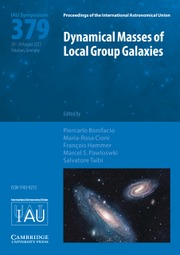No CrossRef data available.
Article contents
Gas trapping in extremely massive clusters in NGC 1365
Published online by Cambridge University Press: 18 January 2010
Abstract
Three radio cm sources in the central star-forming kpc of the closeby barred Seyfert galaxy NGC 1365 are observed. The complete dataset includes VLT infrared J, K, L and N images and spectra. The main observed features include (i) a rising dust continuum towards the mid-infrared (MIR), (ii) bright H emission lines and PAH (polycyclic aromatic hydrocarbon) features, (iii) a bright MIR [Neii] line, and (iv) no detection of MIR [Siv] or [Ariii] lines. For a typical cluster star-formation history and initial mass function, the [Ariii]/[Neii] and [Siv]/[Neii] ratios exhibit an abrupt decrease of several orders of magnitude at an age of ~ 7 Myr. The nondetection of [Ariii] and [Siv] indicates that the clusters are of approximately this age.
- Type
- Contributed Papers
- Information
- Copyright
- Copyright © International Astronomical Union 2010




